“1 is red – right, mom?”
This matter-of-fact question Noah asked Monday morning while doing his math (in my dirty dressing room floor as I hung up clothes) turned his school day on end. What followed was a fascinating day of me interrogating him while becoming more and more intrigued with his brain as he very factually and without hesitation answered all of my inquiries.
“Do all numbers have a color?”
“Yes!”
“0?”
“Black.”
“2?”
“Yellow. 5 is yellow too.”
“3?”
“Blue.”
“4?”
“Orange. And 6, 7, and 8 are purple, 9 is pink. 10 is obviously red and black.”
Now it made so much sense why, after deciding to use colored pencils for math a couple weeks ago, he had started to want to do more math each day.
“What about letters? Do they have colors?”
“Obviously. A is red. B is blue and pink. C is yellow and D is brown. E is orange and F is blue and purple.”
“Days of the week? Do they have colors?”
“Yup. Yesterday was a yellow day and the day before that was a red day. Wednesday is probably a brown day. Brown or beige.”
“So what about Saturdays?”
“What did I just say that they were?? Red, Mom!!”
I had just discovered that my six-year-old had grapheme-color synesthesia. AND I WAS TOTALLY GEEKING OUT.
Grapheme-color synesthesia: When an individual’s perception of numerals and letters is associated with the experience of colors. Like all forms of synesthesia, Grapheme-color synesthesia is involuntary, consistent, and memorable.
I’d heard about synesthesia in all its forms in my psych classes in college (a fascination that I pursued in my electives), and had more recently listened to a podcast about a woman with Mirror-Touch Synesthesia – a very real and terrifying condition that caused her to physically feel everything that she saw anyone else physically experience. Hug, punch, shivers, itches – whatever.
Synesthesia is a phenomenon where two or more senses are triggered by each other in an involuntary way. Color Synesthesia is the most common, and approximately 1% of the population experiences it. A theory is that it is associated from first memories of learning the letters – kids latch onto the colors of their refrigerator magnets, or the letters in their alphabet book. But this was disproven when they discovered synesthetes who couldn’t possibly have had those early life associations. I can’t help but wonder if there is still some connection there, and if more kids have synesthesia now that they learn their letters with blazingly colorful learning apps.
There are many more bizarre synesthesias, such as where you experience tastes when certain words or sounds are spoken, where smells have a color, when time has a spatial place around you, and where letters and other things are personified as little personalities. Often, people who are synesthetes will experience more than one type, so we had other fun conversations yesterday as well, such as,
“What color is the smell of chicken fingers?”
“What?? Mom! That’s disgusting!!”
“Where is Wednesday? Is it to the left or right of you?”
“I have NO idea.”
I found an online test for synesthetes and started Noah on it. It asks you to pick a color from the whole spectrum for each letter and number, randomized and multiple times, to see if you’re consistent with your answers. It was a bit long for a six-year-old’s attention span, however, so we haven’t finished it yet. But it was delightful to listen to his dialogue as he tried to pinpoint the colors.
“No…it’s a little lighter than that…more of a lavender. Mom, how do I get this to be lighter?”
“It’s more of a green-yellow. No, not that green. Not that one either.”
“9 is definitely pink. Not green. Help me get off the green!”
What fascinated me most was his complete consistency. When he got to B on the test, he asked “B is blue and pink. How do I do that on here? Should I just pick one or the other?”
All day long I randomly asked him the color of numbers and letters and he’d shoot back, with complete accuracy, what he’d told me before. I kept a running note in my phone because there was no way I could possibly remember his answers from one ask to the next.
While he was taking the test, Ali walked in and asked what he was doing. I explained to her that Noah saw letters and numbers in color.
“Oh! I do too. 1 is blue, 2 is lime green – “
“WRONG!” Noah didn’t even look up from his test to inform his sister that she was categorically incorrect about the properties of numbers.
Ali wasn’t so convinced that letters had a color, but she did think days of the week had color.
She started going through her list, with very specific colors, like “Tuesday is lime green and light yellow mixed together” and when she got to Friday,
“…and Friday is sunshine yellow…”
Noah piped up, appalled, “What?!? That’s Sunday!! You’re so weird.”
I had never had a more surreal conversation with my children, and I was loving every minute of it. I had turned into psychologist mom and there was no going back.
I found this picture online and showed it to him.
“What is in this picture?”
“Fives and twos.”
“How many twos are there?”
Without taking even a second to count, he said “there are six twos,” then pointed them all out. Because apparently, his brain comprehends them much bolder than my brain does.
(I did ask him if he saw them in color or in black and he looked at me like I was crazy. “They’re black, Mom!!”)
The next morning, I had the kids separately make their color charts.
This is Ali’s:
I checked it against my note, and she Ali stayed consistent with her choices, other than flip-flopping on 5 and 8 being light blue / dark blue.
And this is Noah’s. The really bold characters are due to the fact that they are supposed to be purple, and he wasn’t happy that they looked a little pink on first pass.
The only deviation he made from the day before was that he decided that 7 was actually green, not purple. Additionally, he informed me that uppercase e’s are yellow, but lowercase are orange – and he preferred lowercase. I asked if all uppercase and lowercase letters were different, but he said only e and f – uppercase f is blue and purple (he got mad at himself for forgetting to add blue to it, although he did draw the dual-colored B), but lowercase is beige.
One interesting fact that I found while researching: although each synesthete has their own color-mapping, the majority make A red and O white or black. Noah has consistently told me that A is red and O is blue or black.
I have no idea what this brain phenomenon really effects, other than my children’s minds being delightfully more colorful than my own, but I’m excited to figure out how to integrate it into their education.
As is, apparently, Noah.
So it might be worth the question – offhandedly, out of nowhere, to your kids:
“Hey – what color is the number 5?”
Report your findings immediately.
Note: an update can be found here.

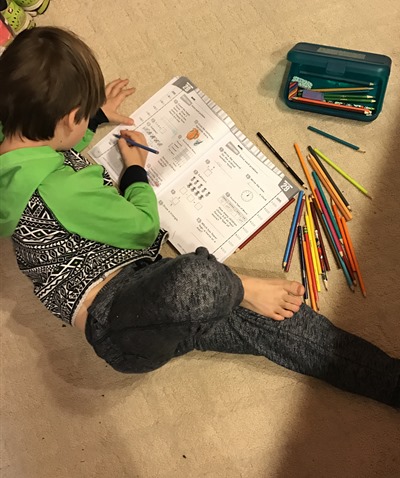
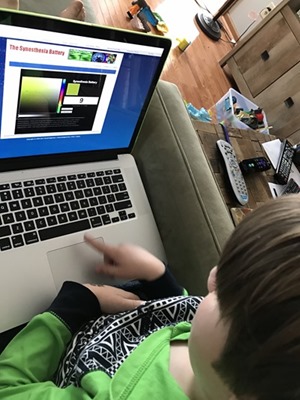
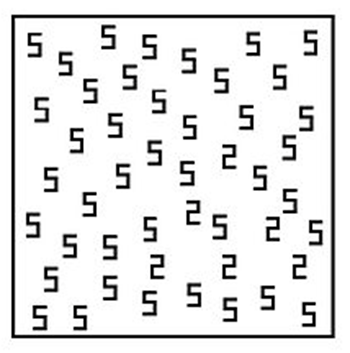
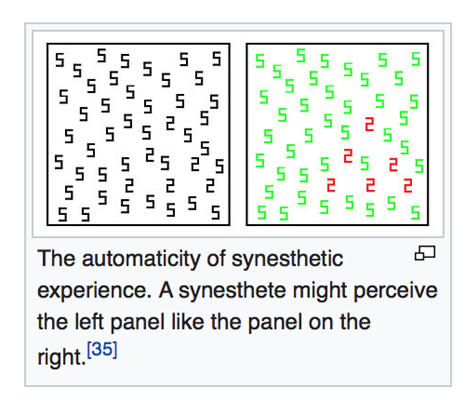
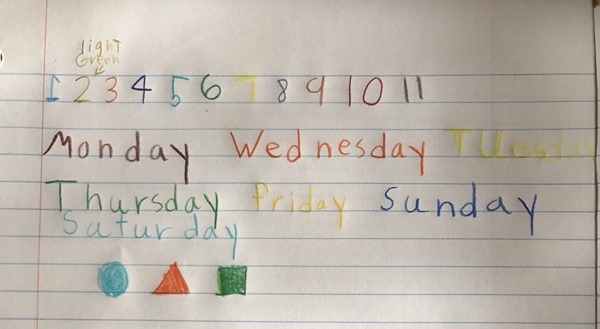
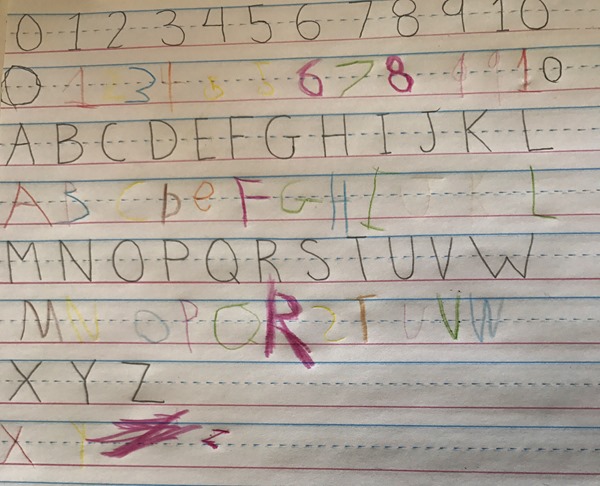
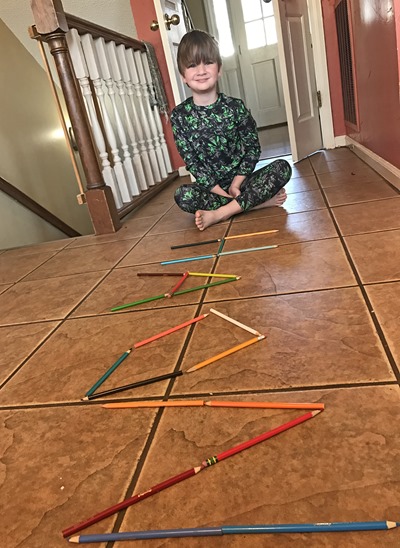
I asked each of my children separately. Here are there answers.
1. 12 yr. old- “What color is the number five? I don’t know. That’s a weird question.”
2. 10 yr. old- “Is this a trick question? Ultraviolet?”
3. 8 yr. old- “It’s no color. Unless you decide to pick a color for it.”
Even as I type this I can hear them discussing this question trying to figure out if it’s a trick question or if there’s a loophole to the “correct” answer. The words “I will die if she doesn’t tell us what color five is” has been said more than once. And now they are chanting outside my door with signs, “Tell us! Tell us! Give us the truth or give us death!” (My kids are extremely dramatic.) I may just let them discuss it longer just to see where it leads.
Thanks!
This is the best interrogation imaginable. I am giggling uncontrollably. Thank you, thank you.
Oy! That should say *their* in the second sentence.
Sheesh. I actually see another error. *Has* should be *have* in another sentence. (Eye roll to myself.). This is what I get for “torturing” my kids with questions like this. If there are any other errors in that comment or this one, please assume I know proper grammar. I shouldn’t care, but unfortunately I do.
Also, I’ve tried sending you a picture via email of what I saw when I came out of my room, but my email service isn’t working properly. Sorry if you get a bunch of copies of it later.
This is so fascinating! How cool that your kids do this! I associate a color with letters of the alphabet, but they go in rainbow order (red orange yellow green blue purple, and then repeat all the way through) because that was the color order of the alphabet chart in my first grade class and apparently, I stared at it a lot. Other than that, I’m sadly lacking in this respect. I will ask my daughters, though. I can’t wait to hear what they say!
Wow, that is so cool! I have never heard of that before and now I need to go ask my children if they see numbers in color as well.
5.5 yr old boy: (looks at my phone to see if there’s a 5 on the screen) I don’t know. Blue. Is it blue?
2.5 year old girl refused to answer.
This is so weird. And so cool!!!
Yep, we experienced this with our middle child. He happens to also be juuuust baaarely “on the spectrum”, so in a sense we went all that surprised to find one more way his brain is really unusual and interesting . There’s newer research that suggests that perhaps that pre-cognitive “thought” is color based– particularly pre-language skills– is color based and so synthesis is kind of a hold-over from infantile thought/language. I’m probably not explaining that perfectly, but that’s my layman’s version of what I’ve been told.
Aaack! So many typos!! I hate texting from my phone!!
When I asked what color is the number 5:
15 yo – blue. I proceeded to ask her all numbers. 4 is red. 2 and 7 is yellow. She only has colors for 0-9 with the exception of 1. She doesn’t know why she doesn’t have a color for the number 1. When I suggested some colors for 1 she was totally disgusted with me
11 yo – how can I know that?
Yikes. 2 and 7 ARE yellow.
Quinn gave me a “look” then said “That’s weird.”
I always loved learning about synesthesia in college.
We have three children, ages 22-17-14. We have known our middle child, Elizabeth, has had this form of synesthesia since she was 4 yrs. old. The other two do not. In addition to most everything having a color, they also have a gender (male/female), and her answers have not changed in 13 years. She excels in everything EXCEPT math… and I’ve always wondered if it doesn’t have something to do with the perceived “color of numbers” being a distraction for her. Sometimes she says things like, “It doesn’t make any sense those numbers would go together; their colors are not complimentary.” I find it all fascinating!
I don’t do the color thing, but letters and numbers have a specific gender to me.
1, 3, 5. 6, 8, & 9 – Male
2, 4, & 7 – Female
B, D, E, F, G, I, L, O, P, Q, R, S, T, V, X, Y, & Z – male
A, C, H, J, K, M, N, U, & W – female
This especially bothers me because I am a huge feminist and I hate that females are also underrepresented in a made up construct in my own mind.
I was going to say that is b/c boys are so odd, but then you have a 6 and an 8 in there :-)
I see colors for two numbers…. 4 and 5. Red and green make 9. Made perfect sense to me….my kids don’t seem to have a touch of this , but one reports that a friend sees music notes as colors. Brains are certainly interesting.
Love this! I have a friend who has sound/color synesthesia. I don’t know if I do officially, but I associate sound, taste, and smell with color as well.
I don’t know anyone in real life with synesthesia but I did once see a really cool episode of Criminal Minds where the unsub (CM code for bad guy) had a form of synesthesia where he saw spoken words and truths were white and lies were red.
Not that I’m comparing your kids to unsubs.
I see music (which I’ve mostly learned to ignore otherwise driving would be SO HARD, but I cannot hear two things playing at the same time or I lose my mind) and taste colors (sorta…it’s hard to explain…like things taste a color, but it’s not always the color that the food item is? If that makes sense) but unfortunately numbers/letters are not colorful to me. That is way cooler in my opinion.
My child sees colors with numbers, letters, and days off the week. But it is in the order of the rainbow. Then black grey brown white repeat.
She might just be totally OCD
I have grapheme-color synesthesia and got all the way to college thinking everyone’s brain worked that way (I think because my sister humored me). It came out one day during a finals week when I was super tired and someone asked me what day I was leaving to go home and I answered “Nine.” They started questioning me and I said, “I meant Thursday, I said nine because nine and Thursday are both brown.” By then a whole table of people were listening and thinking I’d gone crazy and I wished I’d thought up something better to say, but another person piped up and said,”My nine is pink!” Neither one of us knew it had a name, but we did some research and found out all about synesthesia…Just two semesters before I learned about it in my neuroscience class.
I’ve always been good a memorizing in general, but sequences of numbers especially. I used to know lots if phone numbers, back when it mattered. Also, now that I know not everyone experiences the colors I do ( which sounds funny now, but I really thought they did), I use it to do things like write the PIN numbers on the back of my debit cards just incase I do forget. Totally against the bank’s recommendation, but who else is going to know what those little color stripes mean?
Wow I have never heard of this before! Fascinating!
I asked my 14 year old what color was B. He immediately replied blue. I asked several other colors and without missing a beat he stated a color. Just as I thought he might have this synesthesia, he looked at me and said “you are just weird, letters are not colors.” Gotta love the teenage years.
This is so interesting. My husband, 18 year old son and 15 year old daughter were in the room when I asked “what color is number 5?” My son frowned and said “what??” My daughter at first seemed like it was a silly question but then said “blue” right before my husband said “blue”. Then we laughed as they continued to have all the same colors for the numbers even though we had never talked about it before. They did not have colors for the alphabet though. It is so fascinating. Thanks for bringing it to our attention. It made for a very interesting conversation.
That’s fantastic!!!! Thanks for sharing!